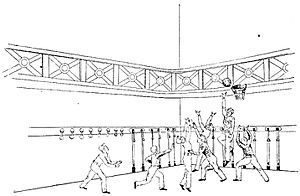History of basketball
Basketball began with its invention in 1891 in Springfield, Massachusetts, by Canadian physical education instructor James Naismith as a less injury-prone sport than football.
A game similar to basketball is mentioned in a 1591 book published in Frankfurt am Main that reports on the lifestyles and customs of coastal North American residents, Wahrhafftige Abconterfaytung der Wilden.
[2] Among other things, a game of skill is described in which balls must be thrown against a target woven from twigs, mounted high on a pole in the middle of a large playing field.
[3] The game of basketball as it is known today was created by Dr. James Naismith in December 1891 in Springfield, Massachusetts, to condition young athletes during cold months.
Upon the request of his boss, Naismith was tasked to create an indoor sports game to help athletes keep in shape in cold weather.
[6] That day, he asked his class to play a match in the Armory Street court: 9 versus 9, using a soccer ball and two peach baskets.
"[8] The eighteen players were John G. Thompson, Eugene S. Libby, Edwin P. Ruggles, William R. Chase, T. Duncan Patton, Frank Mahan, Finlay G. MacDonald, William H. Davis and Lyman Archibald, who defeated George Weller, Wilbert Carey, Ernest Hildner, Raymond Kaighn, Genzabaro Ishikawa, Benjamin S. French, Franklin Barnes, George Day and Henry Gelan 1–0.
[11][12] Shortly after, Senda Berenson, instructor of physical culture at the nearby Smith College, went to Naismith to learn more about the game.
[14] The first official women's interinstitutional game was played barely 11 months later, between the University of California and the Miss Head's School.
At the same time, Bob Gailey went to Tianjin, China,[17] Duncan Patton to India, Genzabaro Ishikawa to Japan, and C. Hareek to Persia.
The first known U.S. college to field a basketball team against an outside opponent was Vanderbilt University, which played against the local YMCA in Nashville, Tennessee, on February 7, 1893.
The Italian team had a white shirt with the House of Savoy shield and the players were: Arrigo and Marco Muggiani, Baccarini, Giuseppe Sessa, Palestra, Pecollo and Bagnoli.
[31] World basketball was growing, but it was on June 18, 1932, that a real international organization was formed, to coordinate tournaments and teams: that day, the following representatives of the 8 national federations: Attilio Ponisio (Argentina), Simeon Mavroskoufis (Greece), Count Giorgio Asinari di San Marzano (Italy), Joseph Shadeiko (Latvia), Henry Brandt (Portugal), D.D.
[34] The first Olympic title was won by the U.S. national team: Sam Balter, Ralph Bishop, Joe Fortenberry, Tex Gibbons, Francis Johnson, Carl Knowles, Frank Lubin, Art Mollner, Donald Piper, Jack Ragland, Willard Schmidt, Carl Shy, Duane Swanson, Bill Wheatley and the trainer James Needles.
As of the early 21st century, the NBA is the most significant professional basketball league in the world in terms of popularity, salaries, talent, and level of competition.
Starting with the widening of the free-throw lane in 1951 and a further extension in 1964, this change was made to reduce the dominant impact of centers who played with their back facing the basket - otherwise known as Post Position.
In the 1980s, former university superstar Earvin "Magic" Johnson of Los Angeles and Larry Bird of Boston once changed the way the game was played.
During and after that, some superstars entered the league, including Charles Barkley, Hakeem Olajuwon, David Robinson, and Michael Jordan.
The league emphasized excitement and liveliness, be it in the color of the ball (red, white and blue), the manner of play, wild promotions, or the three-point shot.
The ABA was folded into the NBA in the summer of 1976, its four most successful franchises (the New York Nets, Denver Nuggets, Indiana Pacers, and San Antonio Spurs) being incorporated into the older league.
With racial segregation affecting all areas of public life in the U.S. including sports, all-black basketball teams (Black Fives) were established in 1904.
The all-white National Basketball League began to racially integrate in 1942 with 10 black players joining two teams, the Toledo Jim White Chevrolets, and the Chicago Studebakers.
[50] After the integration of the NBA, the Harlem Globetrotters started to focus on international touring and exhibition performances, including comic routines.
The U.S. team reclaimed the gold medal in 1976, with Yugoslavia, which had beaten the Soviet Union in the semifinal, finishing runner-up for the second time.
In 1980, with the Americans' absence due to the boycott, Yugoslavia became the third team to win the title, after beating the Soviets anew in the semifinals and Italy in the final.
The Soviet Union entered teams of athletes who were all nominally listed in the military, but all of whom were in fact paid by the state to train full-time.
[54][55][56][57] In April 1989, through the leadership of Secretary General Borislav Stanković, FIBA approved the rule that allowed NBA players to compete in international tournaments, including the Olympics.
[58] In the 1992 Summer Olympics, the U.S. "Dream Team" won the gold medal with an average winning margin of 44 points per game, and without calling a timeout.
Two newly independent countries of the former Yugoslavia and Soviet Union, Croatia and Lithuania, won the silver and bronze medals respectively.
The U.S. won again in 2016, defeating the Serbians in the gold medal game, a rematch of the 2014 FIBA Basketball World Cup Final, after eliminating the Spaniards, who settled for bronze.



